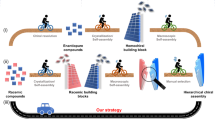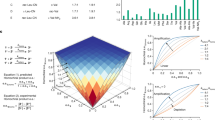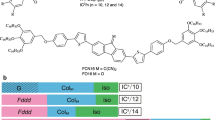Abstract
Recent studies of crystal growth in the presence of specific additives have suggested a new approach to the generation and amplification of optical activity in initially racemic mixtures1–4. This approach is based on the observation that particular enantiomers can be selectively incorporated not only into chiral crystals5–7 but also into the opposite enantiotopic faces of centrosymmetric crystals3,4,8. If one such face of a centrosymmetric crystal is blocked, therefore, enantioselective occlusion into the opposite face will remove one enantiomer preferentially from the racemic mixture. We report here that this process can take place with centrosymmetric crystals of glycine, in a way that may be of relevance to the generation of optical activity during prebiotic evolution. Glycine crystals float in solution, such that only one face is available for growth. The addition of a particular enantiomer of a hydro-phobic amino acid orientates the floating crystals in such a way that the face that occludes amino acids of the opposite chirality is exposed to the solution. Thus, a statistical fluctuation in the orientation of crystals floating in an initially racemic solution could lead to the generation and amplification of optical activity.
This is a preview of subscription content, access via your institution
Access options
Subscribe to this journal
Receive 51 print issues and online access
$199.00 per year
only $3.90 per issue
Buy this article
- Purchase on Springer Link
- Instant access to full article PDF
Prices may be subject to local taxes which are calculated during checkout
Similar content being viewed by others
References
Addadi, L. et al. Nature 296, 21–26 (1982).
Berkovitch-Yellin, Z., Addadi, L., Idelson, M., Leiserowitz, L. & Lahav, M. Nature 296, 27–34 (1982).
Addadi, L. et al. J. Am. chem. Soc. 104, 2075–2077 (1982).
Weissbuch, I. et al. J. Am. chem. Soc. 105, 6615–6621 (1983).
Green, B. S. & Lahav, M. J. molec. Evol. 6, 99–115 (1975).
Addadi, L., Van Mil, J., Gati, E. & Lahav, M. Origins Life 11, 107–118 (1981).
Bonner, W. A. & Kavasmaneck, P. R. J. Am. chem. Soc. 99, 44–50 (1977).
Chenchalah, P. C., Holland, H. L. & Richardson, M. F. JCS chem. Commun. 436–437 (1982).
Albrecht, G. & Corey, R. B. J. Am. chem. Soc. 61, 1087–1031 (1939).
Weinstein, S. Angew. Chem. 21, 218 (1982).
Author information
Authors and Affiliations
Rights and permissions
About this article
Cite this article
Weissbuch, I., Addadi, L., Berkovitch-Yellin, Z. et al. Spontaneous generation and amplification of optical activity in α-amino acids by enantioselective occlusion into centrosymmetric crystals of glycine. Nature 310, 161–164 (1984). https://doi.org/10.1038/310161a0
Received:
Accepted:
Issue Date:
DOI: https://doi.org/10.1038/310161a0
This article is cited by
-
Origin and structure of polar domains in doped molecular crystals
Nature Communications (2016)
-
Question 4: Basic Questions About the Origin of Life: On Chirobiogenesis
Origins of Life and Evolution of Biospheres (2007)
-
A chiroselective peptide replicator
Nature (2001)
-
Parity-violating energy differences of chiral minerals and the origin of biomolecular homochirality
Nature (1985)
Comments
By submitting a comment you agree to abide by our Terms and Community Guidelines. If you find something abusive or that does not comply with our terms or guidelines please flag it as inappropriate.



